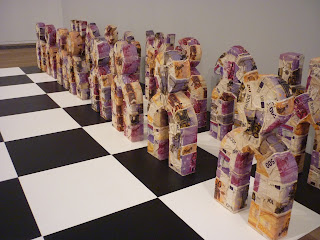Garageland Reviewer Marianna Michael takes us on a guided tour of Meschac Gaba's banknote-stuffed Museum of Contemporary African Art and leaves us time to play with the board games and building blocks.
 |
| The Draft and Architecture Rooms |
The mingling sounds of building blocks crashing to the ground and playful laughter radiate from entrance of Meschac Gaba’s much anticipated exhibition at Tate Modern, a bewildering draw proffered to those about to enter.
Born in 1961 Cotonou, Benin, Gaba conceived the
concept of the Museum of Contemporary African Art during a residency at
the Rijksakademie, Amsterdan in 1996. The now completed work, a 12-room
display, was developed between 1997-2002 and has recently been acquired by Tate
Modern.
The exhibition is sprawling, so much so that not all of the rooms are joined. The Humanist Space, containing golden bicycles originally hired out at Documenta XI as a means to raise revenue for humanitarian causes in Africa, is outside the exhibition entrance, and the Museum Restaurant which will be used to host four dinners over the show’s duration, is on the floor below the main museum area.
The exhibition is sprawling, so much so that not all of the rooms are joined. The Humanist Space, containing golden bicycles originally hired out at Documenta XI as a means to raise revenue for humanitarian causes in Africa, is outside the exhibition entrance, and the Museum Restaurant which will be used to host four dinners over the show’s duration, is on the floor below the main museum area.
Moving through the main entrance of the museum into
the The Draft and Architecture Rooms
it becomes evident that the ruckus is emanating from a blue carpet central
in the space. On the carpet stand a tempting selection of building blocks with which
visitors are encouraged to design, build, adapt and demolish their own
architectural structures. Around the outside of the room collections of items
adorn shelves and rugs. Bags of pebbles, a freezer full of ceramic chickens and
a pile of red ceramic vegetables denote ideas of excessive
food production (and therefore waste) in capitalist economies.
Contrasting with the clamorous construction, the most
serene space in the museum is the Library, a room holding of around
1,600 art publications and children’s books. Whilst visitors sit reading
tranquilly, a coffin in the library corner orates an audio account of Gaba’s
life. The story is narrated in the voice of Gaba’s deceased father and addresses
how the artist believes his father would now perceive him. Hanging above the
reading table chandeliers made of charred books and iron emblematise an African
proverb, which is recounted to me by a gallery attendant: ‘when an old person dies, it is like when a library burns down.’
Money is omnipotent in the show. Whether crushed, hung
on trees or laid out on tables, banknotes feature in almost every room. The
pieces of a giant chessboard are covered in both euro and dollar bills whilst
in other rooms the banknote-coating is applied to more commonplace objects such
as tables and chairs. This approach has been compared with Cildo Meireles’
banknote project, an influence Gaba acknowledges in an interview with Chris
Dercon: ‘I took the painting aspect out of the work, but kept the money.
Because money is the sinews of war; it’s the chief.’
The wall-less exhibition spaces are not filled.
Everything is placed purposefully, and aside from floor-mounted sensor strips
that buzz in warning when a boundary is over-stepped, the rooms are largely
interactive. There is a discernible sense of play, learning and relaxation and
yet each space, each film, artefact and image presents a distinct intellectual
purpose.
 |
| The Salon |
The Salon walls are decorated with white
porcelain birds. A young girl takes to the white polka-dot grand piano and
plays a short section of Tchaikovsky’s Swan Lake. Gaba has created a place
where visitors to the exhibition can spontaneously express their playful
natures as well as their various talents. Non-musical visitors can read, relax,
listen to music, play the already laid-out boardgames, or the sliding puzzle
tables in the next room.
Encompassing a broad scope of ideas Museum of
Contemporary African Art is, as Gaba describes it in interview, ‘an empty museum, but
rich in philosophy’. He explores subjects from knowledge and beliefs to political power and religion. Gaba
explains that he has 'had some very unpleasant nights due to horrible discussions [he's] had about this museum' and that the nature of his museum means that ‘people will ask
themselves questions.’ It is understandable that the project could evoke strong reactions. Gaba has taken strong, often debatable, subjects and presented them publicly and with clear inclination.
 |
| The Library |
For Gaba the structure of the museum addresses the necessity to find a means of display for African contemporary art, but in this instance the
resulting construction is also specifically linked to his personal output as an artist. The rooms are ties together by symbolic repetition and the idea
of play, learning and culture. As you progress through each room your thoughts
develop, and through this process your interpretation of the
knowledge you possess is challenged.



No one is commenting yet many have been to see this. It certainly didnt engage me or my son. A lot of space used for this. It seems to me the public continues to be kept from better work.
ReplyDeleteStephen Goldsmith
If you say so
ReplyDelete